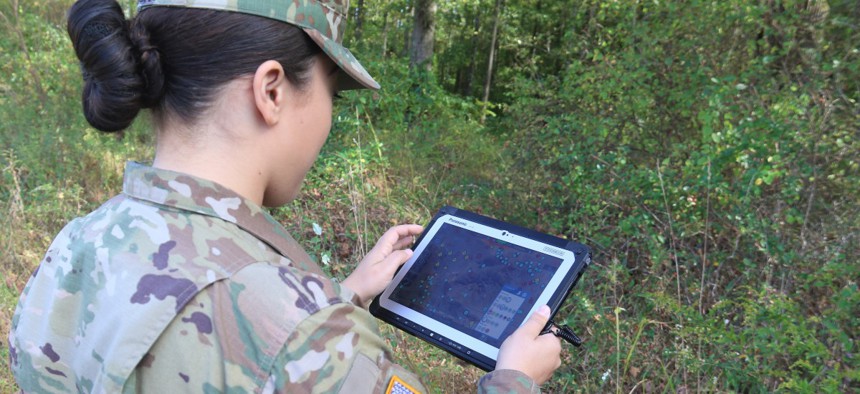
Sgt. Keila Peters tests the Tactical Computing Environment software at Aberdeen Proving Ground, Maryland, in October 2019. Daniel Lafontaine/U.S. Army
DOD Must Put Software at the Core of Its Operations, Report Says
The CIA's chief technology officer and the former head of the Air Force's Project Maven want to yank the Pentagon out of the industrial age into the digital age.
The Department of Defense must adopt new approaches to software design and architecture to help the U.S. military maintain an operational advantage over global adversaries, according to a new report released by the Center for Strategic and International Studies on Wednesday.
The report, “Software-Defined Warfare,” says that the architecture needed to develop and maintain the most advanced warfighting systems “lies in software.”
“One of the greatest challenges the DOD and other U.S. federal agencies face is that they were built from the ground up as industrial-age, hardware-centric organizations,” the report says. “Making the transition to digital age, software-centric, more risk-tolerant organizations is exceedingly difficult. But it is also the only path to future success.”
The paper says that this type of software-defined warfare, where software is at the core of DOD’s operating model, will allow today's military hardware and weapons to better handle “all of the complexity of decisionmaking, targeting and resourcing.”
The report outlines a series of core concepts that DOD should adopt as it works to design and support weapons and accompanying hardware, including moving from vertically-scaled architecture to a horizontally-scaled model that can distribute computing workloads across smaller systems. The report says DOD should acquire or design “a massive number of cheap, disposable and easy-to-manufacture endpoint systems that it can concentrate, distribute and scale up or down as the need arises,” but that it would require almost no maintenance and could be easily remedied if a system breaks down.
The report also suggested eliminating software architectures that have single points of failure; virtualizing systems by wrapping them in “a set of callable application programming interfaces;” adopting a just-in-time software deployment model; and building autonomy into endpoint systems.
During a CSIS event on Wednesday discussing the report’s release, the paper’s authors—Central Intelligence Agency Chief Technology Officer Nand Mulchandani and retired Air Force Lt. Gen. John Shanahan—said that DOD’s ability to adopt and optimize updated software and technologies, including artificial intelligence models, will help the U.S. maintain a competitive footing with other countries that are modernizing their warfighting systems.
Shanahan, who was the inaugural director of DOD’s Joint Artificial Intelligence Center and oversaw Project Maven—the Pentagon’s AI program used to analyze drone footage to identify potential targets—said his time at JAIC demonstrated the limitations of simply adding on AI-enabled machine learning models to outdated systems.
“They were bolt-on solutions to legacy platforms and they would work, but not work nearly as well as they could work if they were designed from the beginning into these weapons systems,” Shanahan said. “So all of the principles that are laid out in the paper are designed to do things much faster, much cheaper and are able to be agile.”
Mulchandani added that, in order for DOD to modernize its software architecture, the agency also needs to move away from the idea of acquisition and procurement as the solution to updating warfighting systems.
“What we need to do is actually get back to the roots of what the DOD used to do in the old days, which is have experts in the fields where we’re going to build or buy something and have those experts on the buy side who actually understand how to actually buy, deploy or build any of this stuff, instead of actually outsourcing all of this intelligence out to the vendors,” Mulchandani said.


